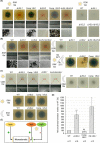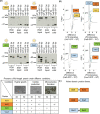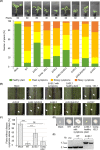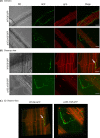The velvet protein Vel1 controls initial plant root colonization and conidia formation for xylem distribution in Verticillium wilt
- PMID: 33720931
- PMCID: PMC7993770
- DOI: 10.1371/journal.pgen.1009434
The velvet protein Vel1 controls initial plant root colonization and conidia formation for xylem distribution in Verticillium wilt
Abstract
The conserved fungal velvet family regulatory proteins link development and secondary metabolite production. The velvet domain for DNA binding and dimerization is similar to the structure of the Rel homology domain of the mammalian NF-κB transcription factor. A comprehensive study addressed the functions of all four homologs of velvet domain encoding genes in the fungal life cycle of the soil-borne plant pathogenic fungus Verticillium dahliae. Genetic, cell biological, proteomic and metabolomic analyses of Vel1, Vel2, Vel3 and Vos1 were combined with plant pathogenicity experiments. Different phases of fungal growth, development and pathogenicity require V. dahliae velvet proteins, including Vel1-Vel2, Vel2-Vos1 and Vel3-Vos1 heterodimers, which are already present during vegetative hyphal growth. The major novel finding of this study is that Vel1 is necessary for initial plant root colonization and together with Vel3 for propagation in planta by conidiation. Vel1 is needed for disease symptom induction in tomato. Vel1, Vel2, and Vel3 control the formation of microsclerotia in senescent plants. Vel1 is the most important among all four V. dahliae velvet proteins with a wide variety of functions during all phases of the fungal life cycle in as well as ex planta.
Conflict of interest statement
The authors have declared that no competing interests exist.
Figures








Similar articles
-
Verticillium dahliae Vta3 promotes ELV1 virulence factor gene expression in xylem sap, but tames Mtf1-mediated late stages of fungus-plant interactions and microsclerotia formation.PLoS Pathog. 2023 Jan 30;19(1):e1011100. doi: 10.1371/journal.ppat.1011100. eCollection 2023 Jan. PLoS Pathog. 2023. PMID: 36716333 Free PMC article.
-
Verticillium dahliae transcription factors Som1 and Vta3 control microsclerotia formation and sequential steps of plant root penetration and colonisation to induce disease.New Phytol. 2019 Mar;221(4):2138-2159. doi: 10.1111/nph.15514. Epub 2018 Nov 5. New Phytol. 2019. PMID: 30290010
-
Rhamnose synthase activity is required for pathogenicity of the vascular wilt fungus Verticillium dahliae.Mol Plant Pathol. 2017 Apr;18(3):347-362. doi: 10.1111/mpp.12401. Epub 2016 Jun 10. Mol Plant Pathol. 2017. PMID: 26996832 Free PMC article.
-
Interactions between Verticillium dahliae and its host: vegetative growth, pathogenicity, plant immunity.Appl Microbiol Biotechnol. 2014 Aug;98(16):6921-32. doi: 10.1007/s00253-014-5863-8. Epub 2014 Jun 15. Appl Microbiol Biotechnol. 2014. PMID: 24928658 Review.
-
Beyond morphogenesis and secondary metabolism: function of Velvet proteins and LaeA in fungal pathogenesis.Appl Environ Microbiol. 2024 Oct 23;90(10):e0081924. doi: 10.1128/aem.00819-24. Epub 2024 Sep 4. Appl Environ Microbiol. 2024. PMID: 39230285 Free PMC article. Review.
Cited by
-
Verticillium dahliae Vta3 promotes ELV1 virulence factor gene expression in xylem sap, but tames Mtf1-mediated late stages of fungus-plant interactions and microsclerotia formation.PLoS Pathog. 2023 Jan 30;19(1):e1011100. doi: 10.1371/journal.ppat.1011100. eCollection 2023 Jan. PLoS Pathog. 2023. PMID: 36716333 Free PMC article.
-
The Velvet Protein UvVEA Regulates Conidiation and Chlamydospore Formation in Ustilaginoidea virens.J Fungi (Basel). 2022 May 4;8(5):479. doi: 10.3390/jof8050479. J Fungi (Basel). 2022. PMID: 35628735 Free PMC article.
-
UvVelC is important for conidiation and pathogenicity in the rice false smut pathogen Ustilaginoidea virens.Virulence. 2024 Dec;15(1):2301243. doi: 10.1080/21505594.2023.2301243. Epub 2024 Jan 19. Virulence. 2024. PMID: 38240294 Free PMC article.
-
Unfolded Protein Response and Scaffold Independent Pheromone MAP Kinase Signaling Control Verticillium dahliae Growth, Development, and Plant Pathogenesis.J Fungi (Basel). 2021 Apr 15;7(4):305. doi: 10.3390/jof7040305. J Fungi (Basel). 2021. PMID: 33921172 Free PMC article.
-
Pseudomonas Strains Induce Transcriptional and Morphological Changes and Reduce Root Colonization of Verticillium spp.Front Microbiol. 2021 May 24;12:652468. doi: 10.3389/fmicb.2021.652468. eCollection 2021. Front Microbiol. 2021. PMID: 34108946 Free PMC article.
References
-
- Wilhelm S. Longevity of the Verticillium wilt fungus in the laboratory and field. Phytopathology. 1955;45:180–181.
Publication types
MeSH terms
Substances
LinkOut - more resources
Full Text Sources
Other Literature Sources
Molecular Biology Databases

